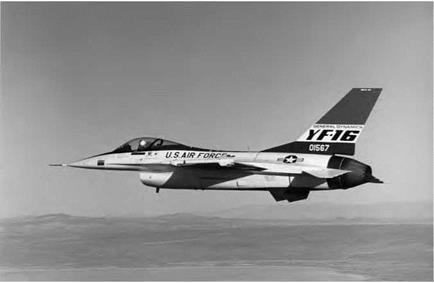Flight Control Systems and Pilot-Induced Oscillations
Pilot-induced oscillations (PIO) occur when the pilot commands the control surfaces to move at a frequency and/or magnitude beyond the capability of the surface actuators. When a hydraulic actuator is commanded to move beyond its design rate limit, it will lag behind the commanded deflection. If the command is oscillatory in nature, then the resulting surface movement will be smaller, and at a lower rate, than commanded. The pilot senses a lack of responsiveness and commands even larger surface deflections. This is the same instability that can be generated by a high-gain limit-cycle, except that the feedback path is through the pilot’s stick, rather than through a sensor and an electronic servo. The instability will continue until the pilot reduces his gain (ceases to command large rapid surface movement), thus allowing the actuator to return to its normal operating range.
The prototype General Dynamics YF-16 Lightweight Fighter (LWF) unexpectedly encountered a serious PIO problem on a high-speed taxi test in 1974. The airplane began to oscillate in roll near the end of the test. The pilot, Philip Oestricher, applied large, corrective stick inputs, which saturated the control actuators and produced a pilot-induced oscillation. When the airplane began heading toward the side of the runway, the pilot elected to add power and fly the airplane rather than veer into the dirt along side of the runway. Shortly after the airplane became airborne, his large stick inputs ceased, and the PIO and limit – cycle stopped. Oestricher then flew a normal pattern and landed the airplane safely. Several days later, after suitable modifications to its flight control system, it completed its "official” first flight.
The cause of this problem was primarily related to the "force stick” used in the prototype YF-16. The control stick was rigidly attached to the airplane, and strain gages on the stick measured the force being applied by the pilot. This electrical signal was transmitted to the flight control system as the pilot’s command. There was no motion of the stick, thus no feedback to the pilot of how much control deflection he was commanding. During the taxi test, the pilot was unaware that he was commanding full deflection in roll, thus saturating the actuators. The solution was a reduction in the gain of the pilot’s command signal, as well as a geometry change to the stick that allowed a small amount of stick movement. This gave the pilot some tactile feedback as to the amount of control deflection being commanded, and a hard stop when the stick was commanding full deflection.[687] The incident offered lessons in both control system design and in human factors engineering, particularly on the importance of ensuring that pilots receive indications of the magnitude of their control inputs via movable sticks. Subsequent fly-by-wire (FBW) aircraft have incorporated this feature, as opposed to the "fixed” stick concept tried on the YF-16. As for the YF-16, it won the Lightweight Fighter design competition, was placed in service in more developed form as the F-16 Fighting Falcon, and subsequently became a widely produced Western jet fighter.
Another PIO occurred during the first runway landing of the NASA – Rockwell Space Shuttle orbiter during its approach and landing tests in 1978. After the flare, and just before touchdown, astronaut pilot Fred Haise commanded a fairly large pitch control input that saturated the
|
The General Dynamics YF-1 6 prototype Lightweight Fighter (LWF) in flight over the Edwards range. USAF. |
control actuators. At touchdown, the orbiter bounced slightly and the rate-limiting saturation transferred to the roll axis. In an effort to keep the wings level, the pilot made additional roll inputs that created a momentary pilot-induced oscillation that continued until the final touchdown. At one point, it seemed the orbiter might veer toward spectators, one of whom was Britain’s Prince Charles, then on a VIP tour of the United States. (Ironically, days earlier, the Prince of Wales had "flown” the Shuttle simulator at the NASA Johnson Space Center, encountering the same kind of lateral PIO that Haise did on touchdown.) Again, the cause was related to the high sensitivity of the stick in comparison with the Shuttle’s slow – moving elevon actuators. The incident sparked a long and detailed study of the orbiter’s control system in simulators and on the actual vehicle. Several changes were made to the control system, including a reduced sensitivity of the stick and an increase in the maximum actuator rates.[688]
The above discussion of electronic control system evolution has sequentially addressed the increasing complexity of the systems. This was not necessarily the actual chronological sequence. The North American F-107, an experimental nuclear strike fighter derived from the earlier F-100 Super Sabre, utilized one of the first fly-by-wire control systems— Augmented Longitudinal Control System (ALCS)—in 1956. One of the three prototypes was used by NASA, thus providing the Agency with its first exposure to fly-by-wire technology. Difficult maintenance of the one-of-kind subsystems in the F-107 forced NASA to abandon its use as a research airplane after about 1 year of flying.











